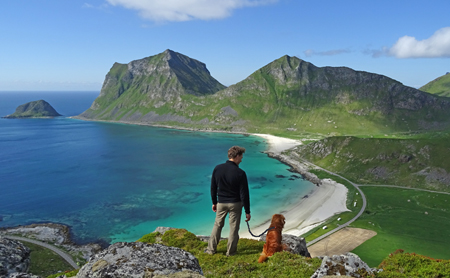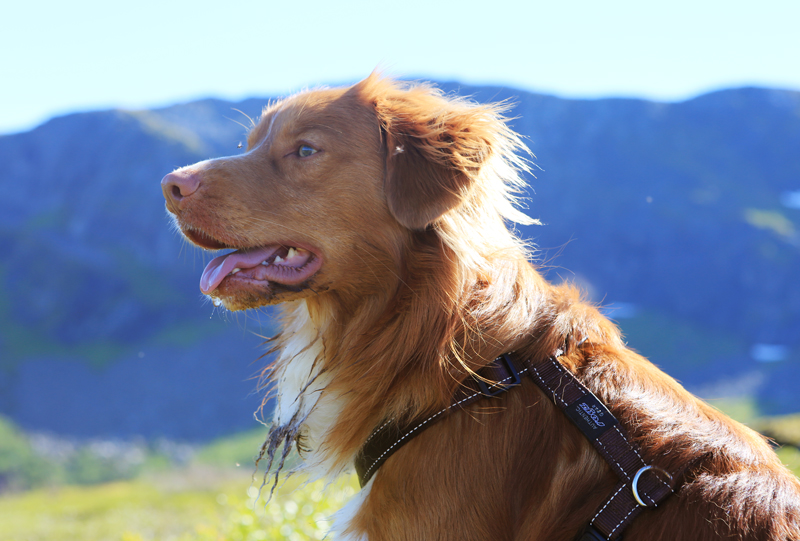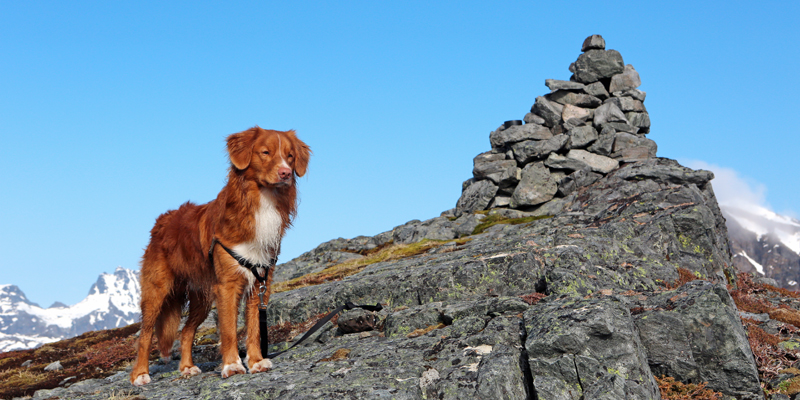Hiking with a dog in the Lofoten Islands
All you need to know before leaving…
What hike would suit my dog?
 The nature of the terrain itself is difficult in the Lofotens (large screes, boulders, high steps to climb), and makes some of the hikes presented on this website simply not suitable for dogs, despite their training or abilities.
The nature of the terrain itself is difficult in the Lofotens (large screes, boulders, high steps to climb), and makes some of the hikes presented on this website simply not suitable for dogs, despite their training or abilities.
Once you're well advanced on a hike, it’s a bit late to discover that the terrain is too tough for your dog. It is also difficult to know if a dog is really tired or if it is in pain. Courageous and faithful by nature, a dog might push itself to follow you with a "smile", just to make you happy. In order to find out if the slopes are not too steep, or if the distances are not too long for your companion, it is very important to take some time to look at the maps before leaving for a hike.
In order to help you choose the right hikes, we have set up a small symbol* on the day-walk sheets. When you see this symbol, it means that you can bring a sporty and healthy dog along. Note that doing the whole trek "The Great Crossing of the Lofoten Islands" is not suitable for dogs.
* soon online
A lightweight dog (small to medium) will do better in difficult terrain
If your dog is athletic and used to rough terrain, the Lofotens can be a nice playground for it. Some hikes however, will be more like a challenging climbing route, as your dog doesn't have your leg length or a pair of arms to lift itself up in the tricky spots. A small-sized dog (or a medium dog, like a border collie for instance) will be rather an advantage here. They are generally more agile, and as you will probably need to give a helping hand from time to time (carrying your dog), it will be easier for you if it is not too heavy.
Exclude long hikes with a fragile dog or puppy
As always, watch out for dogs with weak joints (e.g. hip problems). Do not embark on a too long or too technically demanding hike (with many screes to cross...). Also, if you have a young puppy, it is not advisable to bring him hiking in a mountainous terrain because it could have adverse repercussions on his growth. If you want to bring your puppy anyway, you'll need a backpack to carry him.
Diseases or other dangers
There is no particular disease to be worried about in the Lofotens.
There is no rabies in Norway and almost no ticks, except in the vicinity of sheep pastures, and generally they do not carry any diseases. So just inspect your dog after each hike where you've come across cattle (do not forget a tick twister/removal tool!). The granitic rocks are very abrasive in the long term for the digital pads of the paw (they must be inspected regularly). The water is very acidic in peat bogs and humid soils, and can therefore cause irritation between the dog's pads in the long run. Check this too, especially if your dog starts to bite the underside of its paws ... sometimes until they are bleeding!
> You will find tick removal tools in any local pharmacy (“flåttfjerner” in Norwegian).
Bathing and drinking water
Your companion will be extremely happy in the Lofotens if he loves water and is not chilly, as the sea is ubiquitous. On a hot summer day he will certainly jump into a refreshing lake to cool down. On most hikes, your dog will find lots of freshwater points that are clean enough to drink (streams, lakes), so it is not necessary to load your backpack with tons of water (check on the map if there are accessible water points on the route before leaving for a hike).
> Local supermarkets sell 33 cl bottles with a built-in drinking-trough for dogs; it's very convenient and doesn’t take much space in a backpack. You can refill the bottle during the walk.
Local laws and restrictions
Dogs must be on leash from April 1st to August 20th inclusive. This is indicated by the Norwegian law (“Lov om hundehold”), which is meant to protect farm animals and wildlife. Whatever the time of year, it is essential that your dog stay on a leash wherever there are livestock (sheep, cows...) and in areas where birds nest on the ground, especially during egg-laying (spring). If you forget this, don't worry; Norwegians will not hesitate to call you to order. However, far from homes and livestock, it is not uncommon to meet locals strolling with their unleashed dog. If your dog does not have a strong hunting instinct, it is common sense that matters. When you decide to let your dog walk free (I repeat, away from houses and sheep!), he must remain under your absolute control and come back to you at first call. This is to be taken very seriously, as there are cases in Norway every year of dogs shot by the authorities, or by the farmers themselves, following an "attack" or suspicion of attack on sheep (or similar behavior from dogs). Some local farmers will not hesitate to threaten you physically if your dog is not on a leash when you cross a pasture area (this really happened!). Another obligation: you must - of course - pick up dog leavings, and even if it is in the middle of the wilderness (yes, that’s true). There again, locals will not fail to remind you if you "forget" to do so.
How to cross the Norwegian border with a dog
Before crossing the border (a few weeks before your trip), check that all documents are in order (European pet passport, chip, vaccines, compulsory deworming treatment against echinococcosis, etc.). Whether you arrive by plane or car, you have the obligation to declare your pet to customs when entering the country. They will check the passport and check if your dog's got the compulsory deworming treatment before entering the Norwegian territory (and that this has been done within the legal deadlines).
> To learn more about pet entry requirements, please visit the following page: mattilsynet.no
Taking the ferry with your dog?
For ferry crossings between Bodø and Moskenes (3 hrs 20 min), your dog will have to wait in the car (note that the car deck is not accessible during the crossing). If you are travelling on foot, your four-legged friend will have to stay in a special compartment at the bottom of the boat - near the engines - where it is very noisy (this means in fact: very SCARY for most dogs). There you will find some stainless-steel cages and water. You'll be able to visit your dog during the crossing at least once, on request, or you can stay at its side. Bring a blanket for the cage!
Accommodations:
Most accommodation accepts dogs, but you should check this beforehand and you'll usually have to pay an extra cleaning fee.
Vets in Lofotens
In case of minor or major concern, know that there is a veterinary center in Leknes (https://www.facebook.com/lovetsenter.no/ +47 76 08 29 99) and another in Svolvær (http: //www.lofotendyreklinikk.no/ +47 76 07 16 17).
Travelers’ feedback
Health rules in public areas (cafes, restaurants, shops, etc.) are as strict as they can get towards dogs (except for guide dogs and police dogs) and the fear of allergies - however rare they may be - is close to hysteria in my view.
Unlike many European countries, you will not be able to bring your dog with you while shopping (it's forbidden, and not only in food stores!). You will not be able to drink a coffee inside either. Your four-legged friend will be confined to stay in the car or tied to a pole in the street when you've got things to do in town.
Note that it is also complicated to take the bus with a dog, even if some drivers kindly accept it (on request of course, and if there are no passengers opposed to it).
Although there is a growing craze for dogs in the bigger Norwegian cities (one can even speak of a real trend), they are relatively rare in the Lofoten Islands. Because there are not many of them, and even if they are generally obedient, they are rarely socialized and will often be afraid of your own companion, to which they will respond with surprising aggressiveness. Moreover, fearing drama in the case of a "dog encounter", the locals will keep their fuming and barking hounds on a short leash and may easily make a detour of 50 m or more just to avoid you.
Finally and without wanting to generalize, negative reactions towards you and your dog might surprise you (suspicious looks, sometimes even disgusted looks), especially if you come from the Netherlands, the US, Germany, Belgium or the United Kingdom - where dogs are respected, and have their place next to humans, whether it is in town or elsewhere. This will hopefully change in the future, but slowly, because animal welfare is not a great concern yet and the Norwegian law does still not recognize the sentient nature of animals.

Text and photos by Magdalena (H.-L.)


